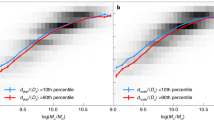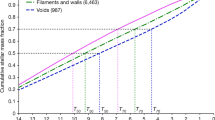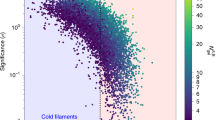Abstract
LARGE-SCALE structure in the distribution of galaxies is thought to have evolved through gravitational instabilities from small density fluctuations in the (largely homogeneous) early Universe. This structure of galaxies consists of rich and poor clusters, connected by filaments and sheets, with regions largely devoid of galaxies (voids) in between1. Numerical simulations of the growth of initial density fluctuations through a nonlinear regime, motivated by the likely physics of the early Universe, also show a network of filaments and voids2,3,18, but the origin of this picture of filaments as the dominant structure was not well understood. Here we show that the 'web' of filaments that defines the final state in these simulations is present in the initial density fluctuations; the pattern of the web is defined largely by the rare density peaks in the initial fluctuations, with the subsequent nonlinear evolution of the structure bringing the filamentary network into sharper relief. Applying these results to the observed galaxy distribution, we suggest that 'superclusters' are filamentary cluster–cluster bridges, and we predict that the most pronounced filaments will be found between clusters of galaxies that are aligned with each other and close together.
This is a preview of subscription content, access via your institution
Access options
Subscribe to this journal
Receive 51 print issues and online access
$199.00 per year
only $3.90 per issue
Buy this article
- Purchase on Springer Link
- Instant access to full article PDF
Prices may be subject to local taxes which are calculated during checkout
Similar content being viewed by others
References
Fabian, A. C. (ed.) Clusters and Superclusters of Galaxies (NATO ASI Ser. C, Vol. 366, Kluwer, Dordrecht, 1992).
Klypin, A. A. & Shandarin, S. F. Mon. Not. R. astr. Soc. 204, 891–908 (1983).
Bertschinger, E. & Gelb, J. Computers Phys. March/April, 164 (1991).
Zel'dovich, Ya. B. Astr. Astrophys. 5, 84–89 (1970).
Zel'dovich, Ya. B., Einasto, J. & Shandarin, S. F. Nature 300, 407–413 (1982).
Peebles, P. J. E. Large Scale Structure of the Universe (Princeton Univ. Press, 1980).
Press, W. & Schechter, P. Astrophys. J. 187, 425–438 (1974).
Bardeen, J. M., Bond, J. R., Kaiser, N. & Szalay, A. S. Astrophys. J. 304, 15–61 (1986).
Bond, J. R. & Myers, S. Astrophys. J. Suppl. Ser. 103, 1–79 (1996).
Kofman, L., Pogosyan, D., Shandarin, S. & Melott, A. Astrophys. J. 393, 437–449 (1992).
Bond, J. R., Kofman, L. A. & Pogosyan, D. Yu. CITA preprint (Canadian Institute for Theoretical Astrophysics, Univ. Toronto, 1996).
Bond, J. R. Nearly Normal Galaxies From the Planck Era to the Present (ed. Faber, S.) 388 (Springer, New York, 1987).
Bond, J. R. in Large-Scale Motions in the Universe, A Vatican Study Week (eds Rubin, V. & Coyne, G.) 419–435 (Princeton Univ. Press, 1989).
Geller, M. G. & Huchra, J. P. Science 246, 897–903 (1989).
Luppino, G. et al. UH-IFA preprint (Institute for Astronomy, Univ. Hawaii, 1996).
Briel, U. & Henry, J. P. Astr. Astrophys. 302, L9–L12 (1995).
Dinshaw, N. et al. Astrophys. J. 437, L87–L90 (1994).
White, S. D. M., Frenk, C., Davis, M. & Efstathiou, Astro phys. J. 313, 505–516 (1987).
Author information
Authors and Affiliations
Rights and permissions
About this article
Cite this article
Bond, J., Kofman, L. & Pogosyan, D. How filaments of galaxies are woven into the cosmic web. Nature 380, 603–606 (1996). https://doi.org/10.1038/380603a0
Received:
Accepted:
Issue Date:
DOI: https://doi.org/10.1038/380603a0
This article is cited by
-
The role of the cosmic web in the scatter of the galaxy stellar mass–gas metallicity relation
Nature Astronomy (2022)
-
Large-scale dark matter simulations
Living Reviews in Computational Astrophysics (2022)
-
Spinning around
Nature Astronomy (2021)
-
Possible observational evidence for cosmic filament spin
Nature Astronomy (2021)
-
Unveiling the faint ultraviolet Universe
Experimental Astronomy (2021)
Comments
By submitting a comment you agree to abide by our Terms and Community Guidelines. If you find something abusive or that does not comply with our terms or guidelines please flag it as inappropriate.



